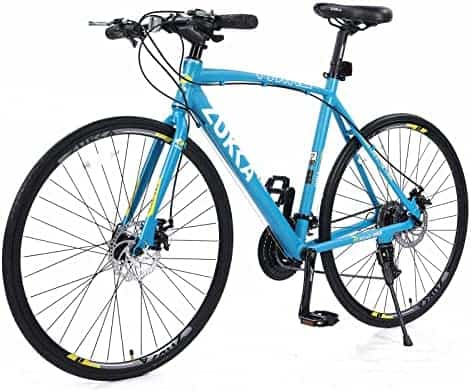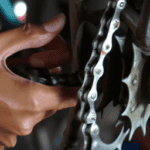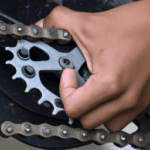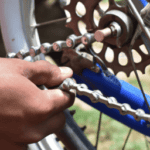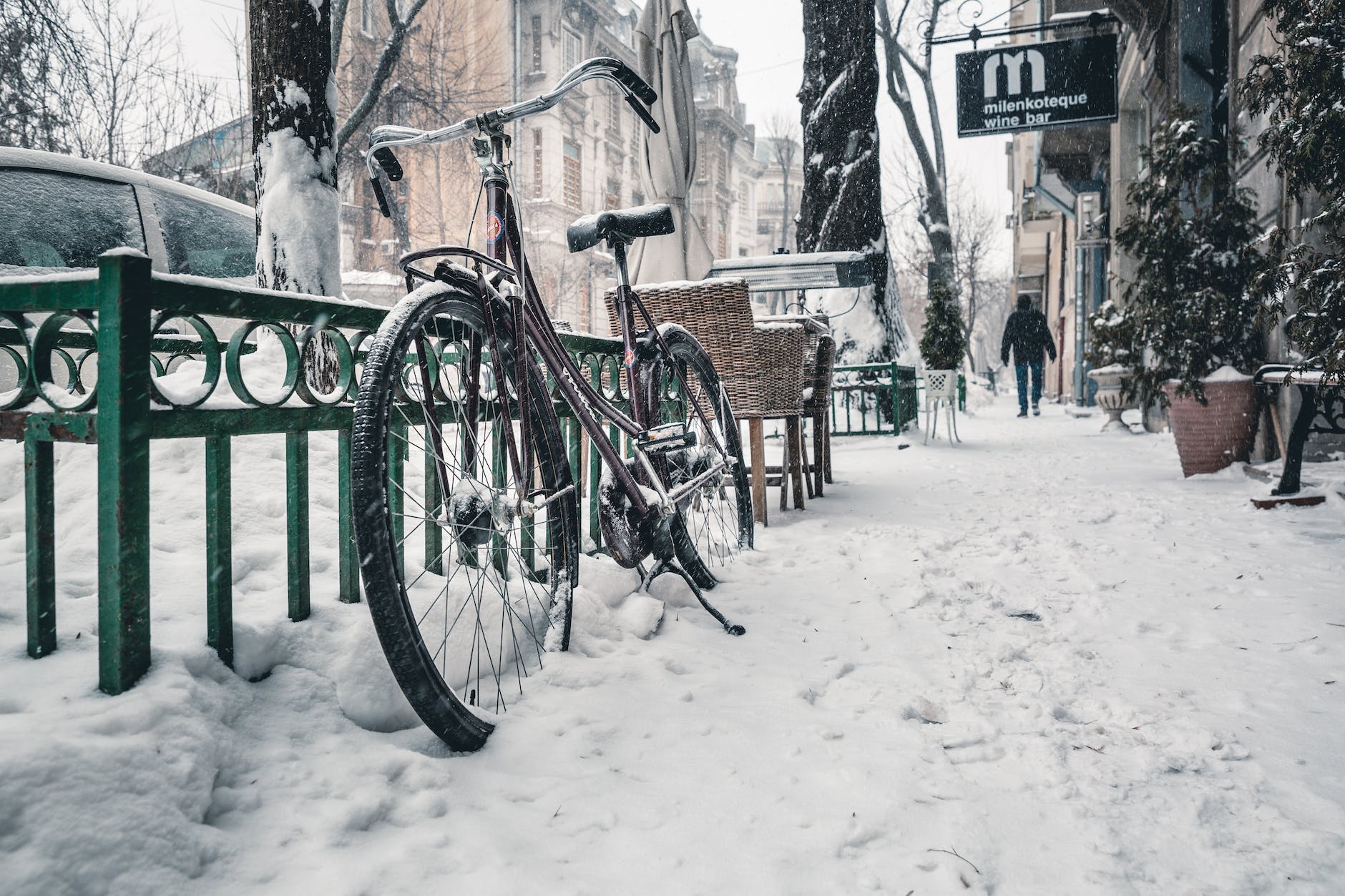Determining the right course of action can be challenging when your bike chain consistently comes off. Various reasons could be at play, and it might require attempting multiple remedies to completely solve the issue. Occasionally, the issue might stem from multiple sources, necessitating a degree of persistence and time.
Cross-chaining
If your bike chain keeps falling off, cross-chaining may be the cause. This practice causes the chain to slant away from the bike and puts tension on it, causing it to wear out faster and require more frequent changes. To fix this issue, you should adjust the sizing of your chain.
Cross-chaining can also lead to a grinding noise when shifting gears. This can be avoided by using a 2x chainring setup, which shifts the chain into a better line when shifting. In addition, you should avoid using wide-ratio chainring sets, which will interfere with the chain.
Cross-chaining is one of the most common causes of bike chain fall-off. Cross-chaining occurs when you shift your chain diagonally from the largest gear in the front to the smallest gear in the back. This will wear down your chain in a short amount of time. In addition, this method puts too much stress on the gears, which can lead to damage.
Another possible cause of bike chain fall-off is incorrect front derailleur settings. It is possible that your derailleur is too small to hold the chain. If so, you need to adjust the front derailleur accordingly. Changing this adjustment can fix your chain fall-off issue.
A bike chain that falls off is dangerous. It can also be a hazard for riders behind you. Experienced cyclists will yell “Chain!” when their chain falls off. And, of course, it is embarrassing. A dropped chain is a hazard, and can lead to a broken chain or even carbon fiber damage.
The first step in fixing this issue is adjusting the height of your bike’s cage. A higher cage will prevent your chain from falling off while a lower one will prevent your chain from running into the larger chainring.
Worn out chain
If you’ve noticed that your bike chain is continually falling off, there are a few things you can do to fix the problem. First of all, you need to remove your old chain and attach a new one. This will stop the chain from popping off as much. Next, check your bike’s setup and make sure it’s aligned properly.
One of the most common reasons why a bike chain keeps falling off is a damaged or defective drivetrain. A damaged derailleur or broken rear axle could be the problem. A stretched chain may also be the culprit. Too much wear will cause the links to stretch and won’t fit properly on the chain cogs.
Another common cause of a falling off bike chain is a bent or misaligned lower pulley. This is a critical component that steers the chain and must be properly aligned with the chain. If the pulley is bent, the chain may fall off when shifting. You can fix this issue by filing down the cage, or you can replace the derailleur. Either way, you should replace the rear derailleur to prevent the chain from falling off again.
A bicycle chain can also be too short. If it’s too long, it will affect the performance of the bike. To check, thread the chain onto the largest sprocket or chainring. Remember to avoid threading the chain through the derailleur. This will allow you to determine how long your chain is. Then, measure the length of the chain by adding two complete links. You can also check the cogs by turning the cranks.
Another way to check if your bike chain is worn is to measure the distance between the two rivets. You can do this by using a chain checker. The tool is very useful if you’re unsure whether the chain is stretched or broken. The device comes with two sides with measurements on them.
Poor shifting technique
The first step to fixing this problem is to check your shifting technique. It’s quite simple to find out if your left hand shifter is too far to the left or right. In either case, your front derailleur will move sideways, and the chain won’t engage with the larger chainring. The chain will then wiggle around in limbo. This is because the ‘click’ of the shifter has waned by the time the chain actually engages the larger chainring.
If your shifting technique is incorrect, it can result in the chain falling off. Ideally, you should shift into a low gear before stopping your bike. This way, your chain won’t be caught in the bike’s gears, and you won’t need to stop pedaling.
If your bike chain is falling off, you may need to make some minor adjustments. You can do this by shifting your chain into the smallest ring of the rear cassette and into the middle or large ring of your front derailleur. If you don’t notice a difference, you can try adding tension to your rear derailleur. To adjust the tension, locate the right barrel adjuster on the brake laterally opposite to the brake lever. The brake cable passes through this adjuster, so you need to turn the barrel adjuster half way away from you.
If you are cycling on rough terrain, poor shifting technique can contribute to this problem. Make sure you plan your shifts well in advance. You can also choose gears that are comfortable for your body. You can also shift into a lower gear before the grade gets steep. This way, you won’t miss gears and avoid too much stress on your body. It is also important to remember that timing is essential when shifting gears when you’re riding on a steep hill.
Too long chain
Bike chain problems can be annoying and can even be dangerous. They can occur because of a worn out chain, excessive length, or rust. They can also occur because of improper transportation and storage. One of the easiest ways to fix this problem is to cut off the excess links from the chain. This can fix the problem and keep you safe when riding your bike. It might take several tries to find a solution that works.
Another common reason for long bike chains is a misaligned derailleur. This misalignment can cause the chain to slip off the cogs. If the chain keeps falling off, the crank tooth may be loose and need to be replaced. It can also cause problems when changing gears because the derailleur cannot pick up the extra length.
If the chain is too long, the first thing you should check is the cage height. If the cage height is too high, it can cause the chain to fall off, while too low will cause the chain to run into the larger chainring. Check the cage height regularly to make sure that the chain is not overly long, as this can make the rear derailleur position loose.
Another common cause for a bicycle chain to fall off is a loose or damaged drivetrain. This problem is often caused by a worn chain or a broken derailleur. If this is the case, you should visit a bicycle shop to fix the problem. If this is not possible, you can try cleaning the rear derailleur, which can prevent your chain from falling off.
The second cause for too long bike chains is a worn drivetrain. If this is the case, you should check the rear derailleur hanger and chainrings. A worn drivetrain will not pick up the extra length of chain, and will lead to the chain dropping off. If the problem is caused by a chain that is too long, the best fix is to return the chain for a new one. Alternatively, you can use a universal chain tool to cut the links off the chain.
Alignment issue
If you keep experiencing bike chain fall-off issues, it may be the result of a minor alignment problem. Dirt and grime can attach to the chain, preventing teeth from fitting in the chainring. The issue can also be caused by improperly-positioned derailleurs.
The first step to resolving this problem is to check the alignment of the lower pulley. In some cases, this issue is caused by a bent lower pulley. To correct this issue, bend the pulley slightly. The chain should not fall off the pulley even when the bike is in lower gears.
Bike chain falling off is the most common bike trouble. It’s neither pleasant nor safe to ride a bike with a falling chain. However, there are some simple ways to resolve this issue, such as changing the chain or the drive chain. But, be aware that if the above two solutions do not work, a new wheel may be required.
If you are unsure of the exact cause of your bike chain falling off, try to identify the cause by taking the bike apart. You can do this by checking the alignment of the chain and checking for worn chainrings. Also, make sure that the rear derailleur is aligned properly. If not, you can try to realign it with a rear derailleur wrench. Keeping the rear derailleur clean will also prevent this problem.

